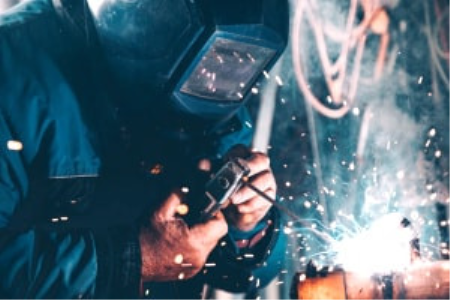0nelove
Active member

Certification in Welding Technology for Engineers (2022)
Last Update: 2/2022
Duration: 3h 30m | Video: .MP4, 1280x720 30 fps | Audio: AAC, 48 kHz, 2ch | Size: 1.5 GB
Genre: eLearning | Language: English
Course for the Students of Manufacturing Engineering or those who want to prepare for the Welding Technology Interview.
What you'll learn:
Understand about the history of welding in details that you can from where this technology start from..
Understand difference between joining and welding with the advantages and disadvantages of welding.
Get idea about the components used in welding ( Consumable and Non Consumable) .
Understand all type of welding joints and type of welds.
Welding as commercial operations and the safety requirement for the welding processes.
Understand in detail about the arc and the shield welding processes.
Deeply Understand all type of welding processes that are used in industries.
Understand about the solid state welding and its types and defects.
Understand all the concepts about the soldering and brazing processes.
Requirements
No previous experience or knowledge is needed. All you need is your time and devotion as well as your curiosity to learn.
Description
This course is designed for the students of Mechanical and Processing Engineers who want to learn all the welding processes for their Examination point of for or for the Students who want to prepare them for the Welding Interview as this course covers all the welding processes in detail. This Course Includes the following topics.
Introduction and Fundamentals of the Welding Process and Welding Safety
Fundamentals of welding
Difference between joining and welding
Advantages and Disadvantages of Welding
History of welding
Types of the welding process
Components used for welding process (Filler material, Flux, and Electrolyte)
Consumable and Non-consumable electrolyte
Welding positions
Welding Electrode Nomenclature
Type of Weld Joints (Butt joint, Corner Joint, Lap joint, Tee Joint, Edge Joint)
Types of Weld (Filler Weld, Groove Weld, Plug weld or slot weld, Spot and Seam weld, Flange and Surface Weld)
Features of Fusion Welded Joints
Physics of welding (Power Density and Numerical of Power Density)
Heat Balance in Fusion Welding
Welding as Commercial Operation
Automation in Welding (Machine, Automatic and Robotic)
Welding Safety
Arc Welding and Shielding and Types of Arc Welding
Welding Categories (Fusion Welding, Solid State Welding, Soldering and Brazing)
Arc Welding
Arc Shielding
The power source in Arc welding
Types of Arc Welding (Shielding metal arc welding, Gas Metal Arc Welding, Flux Cored Arc Welding, Submerged Arc Welding)
Gas Tungsten welding
Plasma arc welding
Understand all Types of Welding in Detail
Oxyfuel arc welding
Oxyacetylene welding
Resistance welding
Spot Welding
Resistance seam welding
Resistance projection welding
Energy beam welding (Electron beam welding, Laser beam welding)
Numerical Problems related to the welding processes
Numerical Problems Related to the Welding Processes
Numerical Problems Related to the welding processes
Solid-State Welding with Types and Defects, Brazing and Soldering
Solid-state welding
Types of solid-state welding
(Diffusion welding, Friction welding, and Ultrasonic welding)
Welding Defects of Solid State Welding
Brazing and Soldering
Successful graduates of the Welding Technology certificate can be employed as entry-level technicians in the welding and metalworking industries. Career opportunities also exist in construction, manufacturing, fabrication, sales, quality control, and welding-related self-employment.
Who this course is for
Undergraduate students of mechanical and processing engineerings.
Those who are in the field of manufacturing technology will also get benefited from this course as it will increase their knowledge.
This course will surely help those who are working in the welding field and have confusions about the processes and materials they can clear their every concept regarding welding with this course.
This course is also for the students who want to prepare these topics for their exams point of view.
Homepage
Screenshots
Code:
https://rapidgator.net/file/99d2cd51fc50eeb7540ab2c1835387d5/certification-in-welding-technology-for-processing-engineers.part1.rar.html
https://rapidgator.net/file/10664bd8f932961b9d26ff20184103b7/certification-in-welding-technology-for-processing-engineers.part2.rar.html
https://uploadgig.com/file/download/48b414734f574c0a/certification-in-welding-technology-for-processing-engineers.part1.rar
https://uploadgig.com/file/download/5ddAc3cFb0757a49/certification-in-welding-technology-for-processing-engineers.part2.rar